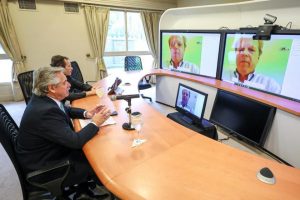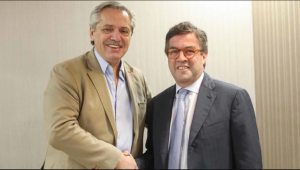Argentina and China are advancing in the negotiations for the construction of Atucha III, the fourth nuclear power plant in our country, with Chinese technology and financing. US officials expressed their concern to the President of the Nation on a recent visit.
The Ambassador of Argentina in China, Sabino Vaca Narvaja, the Secretary of Energy of the Nation, Darío Martinez, and the director of Nucleoeléctrica Argentina, Isidro Baschar, held, on April 6, a meeting with the directors of the National Agency for Energía de China (NEA) and the China Nuclear Corporation (CNNC), in which they agreed to boost negotiations for the construction of the fourth nuclear power plant in Argentina.
The representatives of Argentina and China reviewed the status of the negotiations for the construction of the nuclear power plant in our country with Chinese technology. In addition, they explored the possibility of expanding the bilateral link in other areas of cooperation, such as the Argentine export of services and components for Chinese nuclear projects and the life extension of nuclear power plants in China.
The Secretary of Energy, Darío Martinez, affirmed that “the project of the IV Nuclear Power Plant has the full support of the President of the Nation and is on the list of priority projects between both countries.” Likewise, Sabino Vaca Narvaja explained that “Argentina has a highly developed platform in the nuclear sector with its own developments and a unique scientific base in the region. Achieving our fourth nuclear power plant, in addition to expanding our energy sovereignty, will place us at the forefront of a sector with historical development in our country ”.
For his part, the Deputy Director of the Department of Nuclear Energy of NEA, Qin Zhijun, stressed the importance of nuclear energy in the Chinese development strategy, in particular, considering the need to have a diversified energy matrix, as well as the importance of nuclear energy in the fight against climate change.
Worry in Washington
On April 14, two high-ranking officials of the United States government arrived in Argentina. The Director for the Western Hemisphere of the National Security Council, Juan Gonzalez, and the Acting Undersecretary of the State Department for Western Hemisphere Affairs, Julie Chung, shared a lunch with the President of the Nation, Alberto Fernandez at Quinta de Olivos . Also, in the evening, they shared a dinner with the President of the National Chamber of Deputies, Sergio Massa.
Joe Biden’s government officials asked the Argentine government for “prudence” in relation to China. Likewise, they expressed their concern about the project for the construction of the Atucha III nuclear power plant, with financing and technology from China.
The concern on the part of the United States in the construction of the nuclear power plant with technology and financing from China reflects that Argentina is not exempt from the current political dynamics characterized by competition between the two giants.
Atucha III, the fourth nuclear power plant in the country
The construction of this project is scheduled to be located at the Atucha Nuclear Complex, located in Lima, Zárate district, about 100 km from the City of Buenos Aires. In this same complex are the Atucha I and II nuclear power plants.
According to Nucleoeléctrica Argentina S.A, the negotiations contemplate that the reactor to be built in the new plant is a Hualong HPR1000 Pressurized Water Reactor (PWR) of Chinese origin. How do these reactors work? Basically they use enriched uranium as a source of heat (thermal energy), which is transported by high pressure water to a steam generator, which in turn converts that water into steam that drives an electricity generating turbine. This is the type of reactor most used in the world for electricity generation.
With regard to risks, NASA assures that “the safety levels of the Hualong reactor are significantly high and the risks of delay during construction are reduced.”
This new plant would be capable of generating 1200 MWe of gross energy. To put this in perspective, the Atucha I, Atucha II and Embalse reactors generate 362 MWe, 745 MWe and 656 MWe respectively.
Given the characteristics of the project in question, the type of energy to be used, the controversy regarding the technology to be used and its impact on the external positioning of the Argentine Republic in a context of dispute between the United States and China, from Fundeps we propose the need to that the national State faces the negotiation process in a transparent way and provides a broad framework for debate within Argentine society regarding the project and the use of atomic energy.
More information
- Argentina continues to bet on nuclear power plants with Chinese financing – Fundeps
- Nuclear cooperation between Argentina and China advances – Fundeps
- Negotiations for the construction of a fourth nuclear power plant advance
- Steps move forward for the fourth nuclear power plant
- Biden’s envoys expressed concern about the Chinese nuclear power plant and Huawei
- Pressurized water nuclear reactor (PWR)
Authors
- Mariano Camoletto
- Andres Paratz
Contact
Gonzalo Roza, gon.roza@fundeps.org


